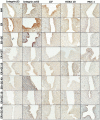Effects of soy isoflavonoids (genistein and daidzein) on endometrial receptivity
- PMID: 33489035
- PMCID: PMC7811811
- DOI: 10.22038/ijbms.2020.48294.11089
Effects of soy isoflavonoids (genistein and daidzein) on endometrial receptivity
Abstract
Objectives: This study aimed to examine the effects of genistein and daidzein on endometrial receptivity by histopathological, immunohistochemical, and biochemical techniques.
Materials and methods: In this study, 72 female Sprague-Dawley rats were randomly divided into 8 groups. The endometrial receptivity model was applied to identified groups. Experimental animals were given periorally 10 mg/kg and high 40 mg/kg doses of genistein and daidzein for 5 days by gavage. At the end of the experiment, uterine tissues were evaluated histopathologically, immunohistochemically, and biochemically.
Results: When histopathological findings were examined, significant decreases in pinopod formation were observed in high dose genistein and daidzein groups. When compared with the endometrial receptivity group, immunohistochemical staining findings showed a significant decrease in the expression of integrin β3, integrin αvβ3, LIF, and HOXA10 and an increase in MUC 1 expression in the high dose of genistein and daidzein groups. In biochemical evaluations, it was determined that genistein and daidzein increased estrogen levels and decreased progesterone levels in a dose-dependent manner.
Conclusion: Genistein and daidzein have a negative effect on endometrial receptivity. Therefore, individuals with a risk of infertility should pay attention to the consumption of genistein and daidzein.
Keywords: Daidzein; Endometrial Receptivity; Genistein; Rat; Soy Isoflavonoids.
Figures
Similar articles
-
Investigation of the endometrial receptivity status in experimental hypothyroid-induced female rats.Iran J Basic Med Sci. 2022 Sep;25(9):1077-1083. doi: 10.22038/IJBMS.2022.63143.13948. Iran J Basic Med Sci. 2022. PMID: 36246072 Free PMC article.
-
Isoflavonoid levels in spot urine are associated with frequency of dietary soy intake in a population-based sample of middle-aged and older Chinese in Singapore.Cancer Epidemiol Biomarkers Prev. 1998 Feb;7(2):135-40. Cancer Epidemiol Biomarkers Prev. 1998. PMID: 9488588
-
Developmental effects of dietary phytoestrogens in Sprague-Dawley rats and interactions of genistein and daidzein with rat estrogen receptors alpha and beta in vitro.Toxicol Sci. 1999 Oct;51(2):236-44. doi: 10.1093/toxsci/51.2.236. Toxicol Sci. 1999. PMID: 10543025
-
Comparison of the effects of genistein and daidzein with dexamethasone and soy protein on rheumatoid arthritis in rats.Bioimpacts. 2011;1(3):161-70. doi: 10.5681/bi.2011.022. Epub 2011 Sep 30. Bioimpacts. 2011. PMID: 23678422 Free PMC article.
-
Stimulation of endometrial glandular cells with genistein and daidzein and their effects on ERalpha- and ERbeta-mRNA and protein expresion.Anticancer Res. 2005 May-Jun;25(3A):1713-8. Anticancer Res. 2005. PMID: 16033089
Cited by
-
Phytoestrogens Present in Follicular Fluid and Urine Are Positively Associated with IVF Outcomes following Single Euploid Embryo Transfer.Int J Mol Sci. 2023 Jun 29;24(13):10852. doi: 10.3390/ijms241310852. Int J Mol Sci. 2023. PMID: 37446033 Free PMC article.
-
Investigation of the effects of rainbow trout (Oncorhynchus mykiss) skin mucus against indomethacin-induced gastric damage in rats.J Mol Histol. 2024 Dec 14;56(1):41. doi: 10.1007/s10735-024-10320-3. J Mol Histol. 2024. PMID: 39673571
-
Lactocaseibacillus-deglycosylated isoflavones prevent Aβ 40-induced Alzheimer's disease in a rat model.AMB Express. 2024 Aug 6;14(1):90. doi: 10.1186/s13568-024-01735-y. AMB Express. 2024. PMID: 39105988 Free PMC article.
-
An Efficient UPLC-MS/MS Method Established to Detect Relugolix Concentration in Rat Plasma.Front Pharmacol. 2022 Jun 16;13:874973. doi: 10.3389/fphar.2022.874973. eCollection 2022. Front Pharmacol. 2022. PMID: 35784757 Free PMC article.
-
Impact of Chemical Endocrine Disruptors and Hormone Modulators on the Endocrine System.Int J Mol Sci. 2022 May 20;23(10):5710. doi: 10.3390/ijms23105710. Int J Mol Sci. 2022. PMID: 35628520 Free PMC article. Review.
References
-
- Dilara Nilüfer DB. Soya ve Soya Ürünlerinin Fonksiyonel Gıda Bileşenleri. Dergipark. 2008;33:241–250.
-
- Dalu A, Haskell JF, Coward L, Lamartiniere CA. Genistein, a component of soy, inhibits the expression of the EGF and ErbB2/Neu receptors in the rat dorsolateral prostate. Prostate. 1998;37:36–43. - PubMed
-
- Wei HC, Bowen R, Cai QY, Barnes S, Wang Y. Anti-oxidant and antipromotional effects of the soybean isoflavone genistein. Proc Soc Exp Biol Med. 1995;208:124–130. - PubMed
-
- Kar PK, Tandon V, Saha NN. Anthelmintic efficacy of genistein, the active principle of Flemingia vestita (Fabaceae): Alterations in the free amino acid pool and ammonia levels in the fluke, Fasciolopsis buski. Parasitol Int. 2004;53:287–291. - PubMed
-
- Cooke PS, Selvaraj V, Yellayi S. Genistein, estrogen receptors, and the acquired immune response. J Nutr. 2006;136:704–708. - PubMed
LinkOut - more resources
Full Text Sources
Research Materials



